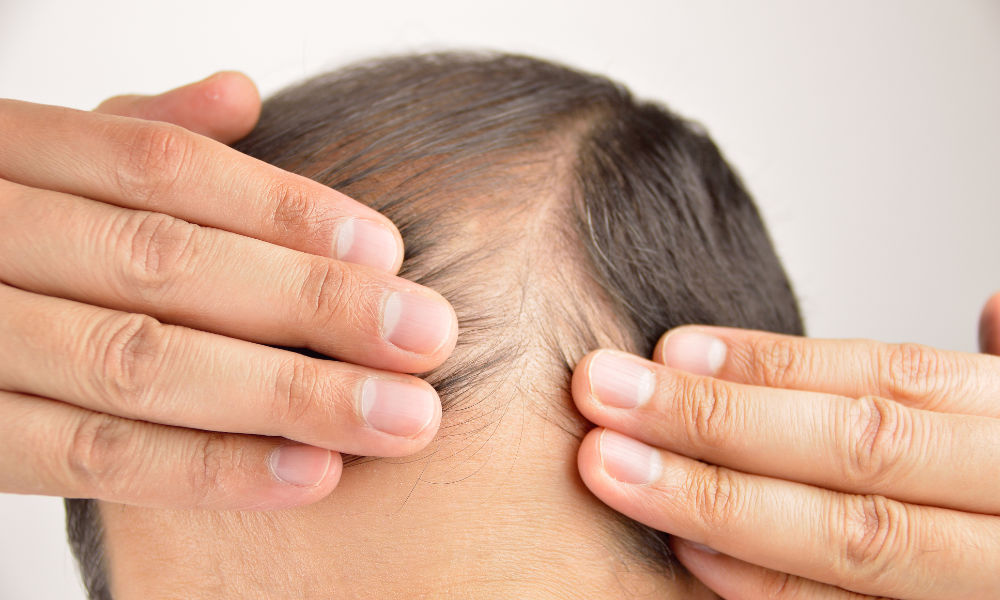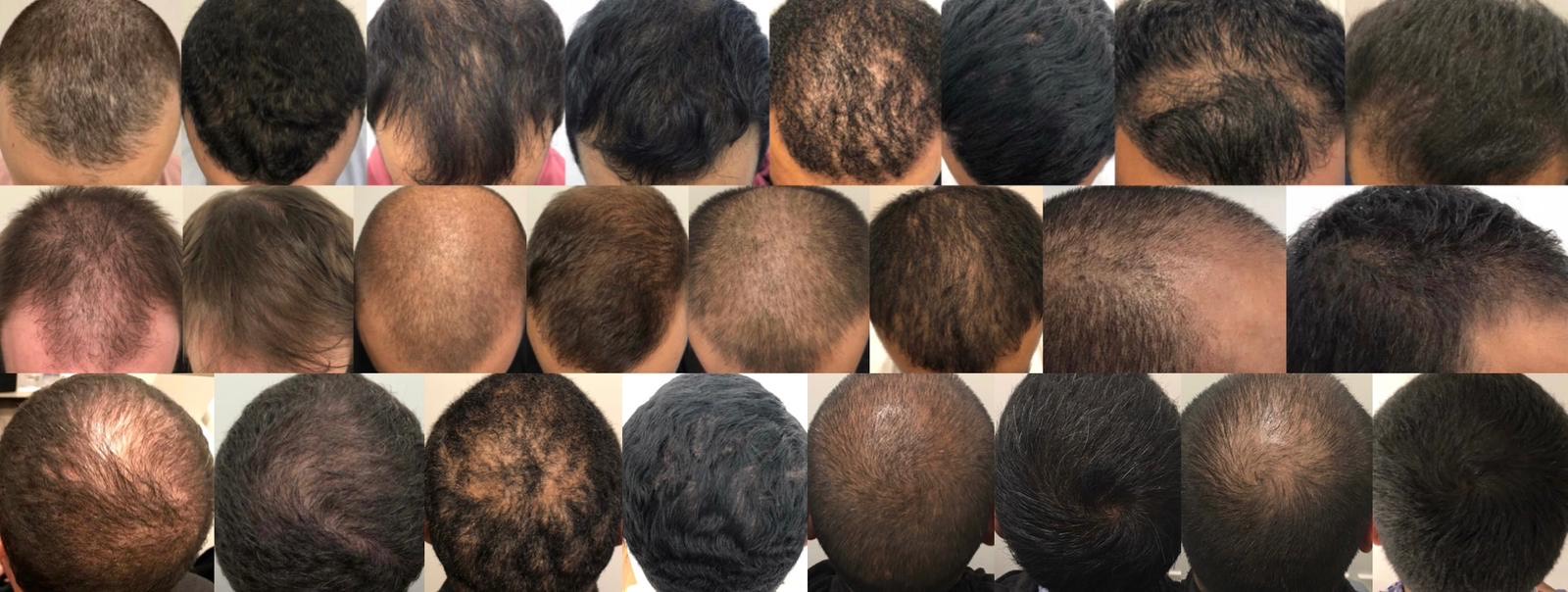Discovering clumps of hair on your pillow or in your shower drain can be alarming, but understanding what causes hair loss can offer some peace of mind. Hair loss, a common concern affecting millions worldwide, spans various causes and influences from genetic factors to lifestyle choices. Recognising the underlying factors contributing to hair loss is crucial for addressing the issue effectively, highlighting the importance of this topic for both individuals experiencing hair loss and those looking to maintain healthy hair.
This guide, from the expert team at Hair and Skin Science delves into the world of hair loss, exploring the common causes that contribute to this condition, the different types of hair loss individuals might encounter, and the risk factors that can exacerbate hair loss. Additionally, we will offer guidance on preventive measures and hair loss treatments available to those struggling with hair loss, and advises when it might be time to seek professional help. By providing a comprehensive overview, this article aims to unpack the root causes of hair loss and equip readers with the knowledge to tackle this challenge confidently.
What is Hair Loss?
Hair loss, often referred to as alopecia, is a condition characterised by the thinning of hair or the absence of hair where it often grows, especially on the head. This phenomenon can vary from a small area to the entire body and can affect individuals of all ages, though it’s more prevalent in adults. Hair loss can result from a myriad of factors including genetics, hormonal changes, medical conditions, and even lifestyle choices. It’s important to note that hair loss is not just a cosmetic issue but can also signal underlying health concerns.
Types of Hair Loss
Hair loss manifests in several forms, each with distinct characteristics. The most common type is androgenetic alopecia, also known as male or female pattern baldness, which is linked to genetic and hormonal factors. Another form is telogen effluvium, characterised by temporary thinning of hair on the scalp due to changes in the growth cycle. Alopecia areata, an autoimmune disorder, results in sudden patches of hair loss. Understanding these types can help in identifying the cause and determining the most effective treatment approach.
Factors Contributing to Hair Loss
Several factors can contribute to hair loss, including:
- Genetics: A family history of hair loss increases the likelihood of experiencing this condition.
- Hormonal Changes: Events such as pregnancy, childbirth, menopause, or thyroid problems can trigger hair loss.
- Medical Conditions: Scalp infections, skin disorders, and diseases like lupus and diabetes can lead to hair loss.
- Medications: Certain drugs used to treat cancer, arthritis, depression, heart problems, and high blood pressure may cause hair loss as a side effect.
- Stressful Events: Emotional stress can cause temporary hair loss.
Impact of Lifestyle Choices
Lifestyle choices, including diet, hair treatments, and styling practices, can also affect hair health. A diet lacking in essential nutrients can lead to weak hair or hair loss. Overuse of hair treatments and styles that pull the hair tight can cause traction alopecia.
In conclusion, hair loss is a multifaceted issue that can stem from various causes. Understanding these underlying factors is crucial for addressing hair loss effectively. While it’s a common condition, it’s advisable to consult healthcare professionals when experiencing significant hair loss to rule out any serious underlying issues and to explore appropriate treatment options.
Common Causes of Hair Loss
Hair loss, a concern for many, can be attributed to a variety of factors. Understanding these can help in identifying the most suitable approach for managing or treating the condition. This section explores the common causes of hair loss, including genetics, hormonal changes, medical conditions, and medications, providing insights into how each can impact hair health.
Genetics
Genetics plays a significant role in hair loss, often dictating the pattern and extent of baldness. Androgenetic alopecia, affecting both men and women, is the most prevalent form of hair loss, influenced by heredity. Studies reveal that the likelihood of experiencing this condition increases if it runs in the family, showcasing a strong genetic predisposition. While men may notice receding hairlines or bald spots, women might see a general thinning of hair, especially after menopause.
Hormonal Changes
Hormonal fluctuations are another pivotal factor contributing to hair loss. Events such as pregnancy, childbirth, menopause, and thyroid imbalances can significantly affect hair health. During menopause, for instance, the decrease in estrogen and progesterone levels can slow down hair growth and thin out hair. Similarly, conditions like polycystic ovary syndrome (PCOS) can disrupt hormonal balance, leading to hair loss among other symptoms.
Medical Conditions
Various medical conditions can also lead to hair loss. Alopecia areata, an autoimmune disorder, results in patchy hair loss. Scalp infections and diseases such as lupus and diabetes might contribute to the condition as well. Furthermore, psychological factors like stress and trichotillomania, a disorder where individuals pull out their hair, can exacerbate hair loss.
Medications
Certain medications have been identified as potential culprits for hair loss. These include, but are not limited to, drugs for cancer treatment (chemotherapy), antidepressants, blood thinners, and high blood pressure medications. Chemotherapy, for example, is known for causing anagen effluvium, a severe form of hair loss. However, it’s important to note that hair loss due to medication is often reversible upon stopping the drug.
Understanding the root causes of hair loss is crucial for effective management and treatment. Whether it’s through genetic testing, hormonal therapy, addressing underlying medical conditions, or reviewing medication use, there are various approaches to combat hair loss. However, it’s essential to consult with healthcare professionals to determine the most appropriate course of action based on individual circumstances.
Types of Hair Loss
Understanding the various forms of hair loss is essential for identifying the right treatment and management strategies. Here, we delve into the most common types of hair loss, including Androgenetic Alopecia, Telogen Effluvium, Alopecia Areata, and Anagen Effluvium, offering insights into their causes, characteristics, and effects on individuals.
Androgenetic Alopecia
Androgenetic Alopecia, widely known as male or female pattern baldness, is a genetically predetermined condition influenced by an excessive response to androgens. This type of hair loss affects up to 50 percent of males and females, with symptoms occuring any time after puberty. Men typically experience hair loss in the vertex and frontotemporal regions, while women undergo diffuse apical hair thinning, retaining their frontal hairline but witnessing a broader appearance of the anterior part of the scalp. The condition is characterized by the progressive loss of terminal hair on the scalp, resulting from the activation of androgen receptors which shorten the anagen phase and lead to follicular miniaturisation.
Telogen Effluvium
Telogen Effluvium is identified by a sudden thinning of hair across the scalp due to a large number of hairs entering the resting phase simultaneously. Triggered by severe stress or significant changes to the body, this form of hair loss can be acute, lasting fewer than six months, or chronic, persisting for longer periods. Symptoms include increased hair shedding, noticeable thinning, and dry hairs that fall out easily. Various factors such as high fever, childbirth, psychological stress, and certain medications can precipitate this condition. Although it can be alarming, hair typically regrows within three to six months without treatment.
Alopecia Areata
Alopecia Areata is an autoimmune disorder causing patchy hair loss that can occur on any body part, but it most commonly affects the scalp. This condition can lead to several patterns of hair loss, ranging from small, round patches to complete baldness of the scalp (Alopecia Totalis) or even the entire body (Alopecia Universalis). Individuals may also experience changes to their nails, such as dents or pits, and a burning sensation where hair loss will soon begin. Alopecia Areata’s unpredictable nature means hair may regrow and then fall out again, with each case being unique to the individual.
Anagen Effluvium
Anagen Effluvium results from an acute injury to hair follicles during the growth stage, leading to sudden and diffuse shedding of structurally damaged hairs. This type of hair loss is most commonly associated with chemotherapy but can also affect individuals with autoimmune conditions. Unlike Telogen Effluvium, where hair shedding occurs during the resting phase, Anagen Effluvium involves the rapid loss of hair that may affect the entire body, including eyebrows and eyelashes. Although it can be distressing, hair regrowth is possible once the underlying cause is addressed, with full recovery expected within 3-6 months after stopping chemotherapy.
Each type of hair loss presents its own set of challenges and emotional impacts on individuals. Understanding these different forms is a crucial step towards finding the most effective treatment and coping strategies.
Risk Factors Associated with Hair Loss
Understanding the risk factors associated with hair loss can empower individuals to take proactive steps in managing or preventing this condition. While genetics play a significant role, other factors such as age, family history, nutritional deficiencies, and stress also contribute to the likelihood of experiencing hair loss. Here, we explore these risk factors in detail.
Age
As individuals age, changes in hair colour, texture, and density are common. Hair follicles produce less melanin, leading to gray hair, and many hair follicles stop producing new hairs altogether. This process can result in thinning hair or visible scalp. Men may start showing signs of baldness by their 30s, and many are nearly bald by age 60. Women can experience a similar type of baldness, known as female-pattern baldness, where hair becomes less dense, and the scalp may become visible as they age.
Family History
A strong correlation exists between family history and the likelihood of developing hair loss. Studies have shown that individuals with a family history of hair loss, particularly on the mother’s side, are more likely to experience hair loss themselves. For example, a positive family history was noted in 69% of patients with Female Pattern Hair Loss (FPHL), and hair loss in one parent was observed in 53% of patients. These statistics underscore the significance of genetics in the development of hair loss.
Nutritional Deficiencies
Nutritional deficiencies can significantly impact hair health, leading to conditions such as acute telogen effluvium, a result of sudden weight loss or decreased protein intake, and diffuse alopecia seen in niacin deficiency. Iron deficiency, the most common nutrient deficiency globally, can cause hair loss by disrupting the normal hair growth cycle. Similarly, low levels of vitamin D and zinc are associated with various hair loss conditions. It’s essential to maintain a balanced diet rich in essential nutrients to support hair health.
Stress
Chronic stress is a well-documented risk factor for hair loss. Research has linked long-term stress to increased levels of corticosterone, which inhibits hair regrowth by acting on the dermal papilla. The dermal papilla, in turn, fails to secrete GAS6, a molecule crucial for activating hair follicle stem cells. Managing stress through lifestyle changes and stress-reduction techniques can help mitigate its impact on hair health.
Understanding these risk factors can help individuals identify potential causes of hair loss and seek appropriate interventions. Addressing nutritional deficiencies, managing stress, and being aware of the genetic predisposition can aid in preventing or slowing down hair loss.
Preventive Measures and Treatments for Hair Loss
Hair loss can be a distressing condition, but fortunately, there are several preventive measures and hair loss treatments available that can help manage this issue. From topical treatments and medications to lifestyle modifications, individuals have various options to explore. Understanding these can empower those experiencing hair loss to take proactive steps towards managing their condition.
Lifestyle Modifications
Making certain lifestyle changes should be the first step you take towards healthier hair and potentially slow the progression of hair loss:
- Gentle Hair Care: Opt for a gentle shampoo, use a moisturising conditioner, and limit the use of heat styling tools to reduce hair damage.
- Nutritional Support: Ensure a balanced diet rich in essential nutrients. In some cases, supplements might be beneficial, but it’s important to consult with a healthcare provider before starting any new supplement regimen.
- Stress Management: Chronic stress can exacerbate hair loss, so incorporating stress-reduction techniques such as yoga, meditation, or regular exercise can be beneficial.
- Scalp Massage: Regular scalp massages may increase hair thickness by stimulating blood flow to the scalp.
Remember, the effectiveness of these treatments and modifications can vary from person to person. It’s important to have realistic expectations and patience when exploring these options. Consulting with a dermatologist or a hair loss specialist can provide personalised advice and treatment plans tailored to individual needs and conditions.
When to Seek Professional Help
Noticing changes in your hair can be concerning, whether it’s a thinning hairline or an increase in hair shedding. It’s crucial to understand when these changes warrant professional attention. Here, we outline scenarios and symptoms that indicate it’s time to consult a healthcare provider for your hair loss concerns.
Identifying the Need for Professional Assistance
-
Persistent Changes in Hair Volume or Density: If you observe continuous thinning or bald spots that worsen over time, it’s essential to seek professional advice.
-
Unusual Symptoms Accompanying Hair Loss: Experiencing symptoms such as itching, burning, or discomfort on the scalp could indicate an underlying issue that requires medical attention.
-
After Trying Lifestyle Solutions: If there’s no improvement in your hair condition after changing lifestyle habits, consulting a hair loss treatment provider can offer alternative solutions.
What to Expect During Your Appointment
During your visit, a registered medical professional from Hair and Skin Science will likely:
- Review Your Health History: This includes discussing any recent illnesses, surgeries, life stressors, and family history of hair loss.
- Conduct a Physical Exam: A thorough examination of your scalp to observe the pattern and extent of hair loss.
- Order Blood Tests: To check for nutrient deficiencies or signs of underlying conditions that might be contributing to hair loss.
Additional Tips for Managing Hair Loss
- Use Gentle Hair Care Products: Opt for a mild baby shampoo and consider washing your hair less frequently if it’s not overly oily.
- Be Open About All Symptoms: Mention any other unusual symptoms you’ve noticed, such as fatigue, unexplained weight loss, fever, changes in bowel movements, or skin changes, to provide a comprehensive view of your health.
Understanding when to seek professional help and what to expect during your appointment can significantly impact the management and treatment of hair loss. By taking proactive steps and consulting with healthcare professionals, individuals can explore the underlying causes of their hair loss and embark on a journey towards effective solutions.
How Hair and Skin Science Can Help
Through exploring the diverse causes, various types, and multiple treatments of hair loss, this article highlights the complexity of the condition while emphasising that effective management is within reach. It is clear that while genetics play a pivotal role, factors such as hormonal changes, lifestyle choices, and proper nutrition also significantly influence hair health. Equipped with this knowledge, individuals are better prepared to identify the early signs of hair loss, understand its root causes, and choose the most suitable preventive measures or treatments.
Moreover, recognising when to seek professional help is an essential step towards addressing hair loss effectively. Consulting with the team at Hair and Skin Science can provide tailored solutions and support that over-the-counter treatments may not offer. Ultimately, while hair loss can be a distressing experience, understanding its underlying causes and available treatments opens the door to more effective management and, in many cases, a positive outcome. With patience and the right approach, individuals can navigate through the challenges of hair loss towards achieving healthier hair.




